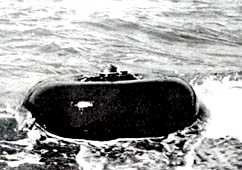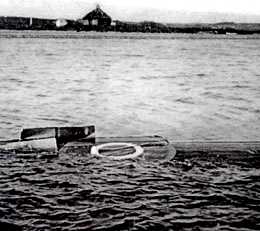207 SQUADRON ROYAL AIR FORCE HISTORY
AN 'UNKNOWN AIRMAN' NO MORE
Lancaster W4945 EM-Z ,RAF Langar, 28th April 1943
Lemvig, Denmark

28th April 1943, 207 Squadron, RAF Langar, Nottinghamshire
Lancaster W4945 EM-Z took off from RAF Langar at 2055 on 28th April 1943 as part of a major mine laying ('Gardening') operation off the coast of Denmark, in the area code named Daffodil (The Sound). The crew was:
| Pilot | Warrant Officer Kenneth Rees RAFVR |
| Flight Engineer | Sgt
George Tyler RCAF |
| Navigator | Pilot Officer Patrick Mockford RAFVR |
| Wireless Operator | Flying
Officer Leonard Foulds RAFVR |
| Bomb Aimer | Sgt Thomas Ellingham RAFVR |
| Mid Upper Gunner | Sgt Stanley Cowham RAFVR |
| Rear Gunner | Sgt Alexander Cochrane RAFVR |
|
The two Air Gunners were commemorated on the Runnymede Air Forces Memorial to those with No Known Grave. Jim Cochrane's brother Alex was one of them. He had left his lucky white heather behind, safely wrapped in a strip of tartan paper. The RAF sent it on to his parents in a little cardboard box a month after he went missing. A brother's questJim Cochrane's research on his brother's death found that the Germans realised that the Limfjord was a useful navigational landmark. |
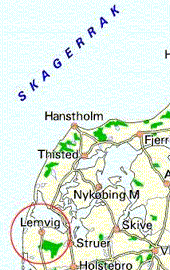 |
Anti-aircraft batteries and searchlights were placed at the bridges. The bridge at Oddesund, which spans the East end of the Limfjord, was defended by a German gun emplacement on the quay next to it.
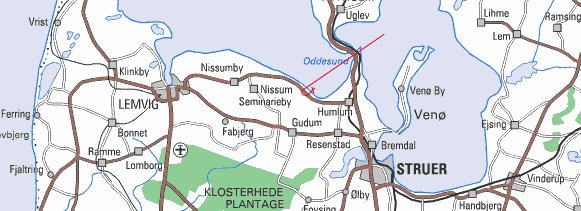
As there was low cloud, EM-Z was possibly flying low to pick up landmarks. Recent research among witnesses suggests that the Lancaster might already have been in trouble with one or two of the engines, possibly on fire, and that as it came down the landing lights were on (the probable track is marked on the map above). All agree that the Oddesund bridge battery shot down Alex's plane. Another aircraft may have fired at the battery.
The crew, apart from the pilot, may have baled out after the plane was hit at the bridge. The plane ditched in the fjord about 200 metres from the shore. However, reaching land was evidently too much for the crew and all were thought to have drowned.
|
|
|
Alex's best friend George McMillan, who had also been in the RAF, had visited Lemvig after the war to see what had happened to his friend. He told the Cochranes that he had been shown pictures by the then head gardener of the Germans burying Allied airmen with full military honours and this had happened with EM-Z's crew. However it seems these photos were later taken away.
In the Summer of 1993 Jim and his wife Margaret included a visit to Lemvig in a five week tour of Europe. In the small cemetery the arrangement of the graves was at first confusing but the head gardener was very helpful and showed them the burial records. Five of the crew, including an unknown airman, had been buried on 5th May 1943. On May 20th P/O Mockford was laid to rest; two days later a second unknown airman was buried beside him and on the 29th May a third unknown airman was buried.
".. then something happened"
The Cochranes wondered which of the two unknown airman graves was Alex's? Jim had never liked the idea of Alex being 'an unknown airman' and intended to do something about it. He had brought with him a small stone engraved with Alex's name, rank and nationality. He placed this on one of the unknown airman graves as a temporary measure, not knowing then that private markers are not allowed, the Commonwealth War Graves Commission policy being equality for all.
As he took his leave of the grave he'd adopted for his brother, thinking that he'd not ever be back, Jim touched the headstone "..then something happened. I have no explanation and I can't describe how it felt. I'm not a fanciful person but when I touched the headstone I had the strangest feeling."
Three weeks later Jim suffered a heart attack. During the months he took to recover he kept thinking about Alex not having a proper tombstone. Aided by George McMillan he began a frustratingly slow search for information from official sources. Eventually he found himself travelling to the Public Record Office at Kew in London.
By good luck, on the train to Kew he met a lady whose hobby involved spending a lot of time at the PRO. With her help he was quickly looking at the microfilmed records of his brother's time on 207 Squadron. From January 3rd to 29th April 1943 Alex Cochrane had been on 19 operations, including two trips to Berlin. Jim was very proud of his brother and crew.
Light at the end of the tunnelThen one morning Jim had a reply to his letter to the Commonwealth War Graves Commission. This explained that all the Lemvig graves had been examined in 1947 in order to identify casualties previously recorded as 'unknown'. Despite these exhumations it had still proved impossible to identify the graves of Sgts Cochrane and Cowham. Half a century later, having looked into their records, the CWGC were still doubtful. |
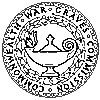 |
In Grave 697 was someone who was found along with four crew from Alex's 207 Sqn Lancaster EM-Z. Grave 707 probably contained the seventh member of the crew. The physical characteristics recorded of the casualties had not permitted further identification as to who was who.
The Commission had recently learned that some police records on the finding of airmen's bodies still existed. Attempts would be made to uncover more information. Referring to the plaque that Jim had placed at grave 697, he was informed about the CWGC policy of equal treatment for all. However the plaque would not be removed until there had been results from the further inquiries. "Needless to say, if it is possible to prove that your brother is buried in grave 697, or for that matter 707, we would arrange for a new headstone to be erected, inscribed fully with his personal details."
Detective work
Jim phoned the writer of the letter to thank him sincerely. When he asked if anything significant had been found when graves 697 and 707 had been exhumed, his voice must have conveyed some concern.
"Mr Cochrane" said the CWGC chap softly "Please understand
that after the war there was no one more interested in finding out who
was buried where than the Commission. And to find out for certain it was
absolutely necessary to dig up every unknown serviceman's grave, a
mountain of them, and examine the contents. As a result, of the graves
in question at Lemvig Cemetery the taller of the two bodies had no hair
whilst the other's was combed straight back and coloured dark brown."
"That was Alex!" replied Jim "That was how he had his hair and the same
dark brown colour is in his service record."
Then he put the big question. "Tell me, which grave housed that body?"
"It was the one you marked, Mr Cochrane."
He went on to tell Jim about a retired Colonel living in Denmark who was doing excellent research work on behalf of the Commission. He also asked Jim to have patience because such investigations always took a long time.
| That night Jim searched for some
photos to send to the CWGC to perhaps speed things up. One
showed Alex's hair style. Others revealed something Jim felt
might be highly significant. Alex had a distinct gap between
his two front teeth. A fortuitous visit to the dentist and
even bigger enlargement of Alex lead to the conclusion that
Alex had Median Diastema - what dentists call the gap between
the two front teeth when it occurs in adults. The same day Jim
posted the photos to the CWGC.
When he had heard nothing a month later he called to ask his contact there if the photos had been of any use. There was a certain caginess about the reply "Yes and no". Then, very quietly, "Mr Cochrane, in the exhumation report for grave 697 it states that the face was bashed in." Six weeks later Jim and his wife were at the CWGC going over the case file and took the opportunity to visit the Runnymede Memorial overlooking the Thames. They found Alex's name on panel 145 and Stanley Cowham's on panel 146. |
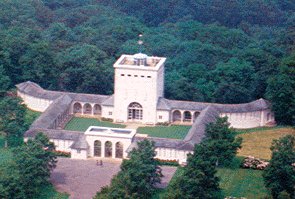 Runnymede Air Forces Memorial, on a hill above the Thames, dedicated to those who were lost on air operations in NW Europe and have no known grave. |
At last
Almost two years and two months after the Cochranes' visit to Lemvig, the CWGC wrote to say that as a result of their investigations they were "now satisfied that the two graves in question in Lemvig cemetery, numbers 697 and 707, belonged to Sgt Alexander Wilson Cochrane and Sgt Stanley William Cowham, respectively".
Jim could have an inscription placed at the base of Alex's new headstone. He chose to base it on a verse from Philippians - 'Into the peace that passeth all understanding'.
Eight months later, in June 1996 came a letter from Neils Erik Stampe in Denmark. He explained that on behalf of the CWGC he had been talking to the local people. The evidence was to be placed in a local archive. He expressed his admiration for the servicemen buried at Lemvig and often visited their graves. He had got the Cochranes' address from the Lemvig Cemetery office when Jim's wife had written to thank them. Partly through that link, the story of what really happened to the crew unfolded.
The Denmark TeamIn late 1993 a small group of retired people, headed by Colonel Helge William Gram, formed a team of researchers doing voluntary work on behalf of the CWGC. Neils Erik Stampe was the member investigating Alex Cochrane's case. His report to the CWGC took six months to complete. He found eight eye-witnesses to the crash and his report included a map showing where each body had been found as well as an estimate of the final flight path of the stricken Lancaster. He even included copies of old newspaper photos of the crashed plane. The story that all the crew had drowned had always troubled Jim. What happened to the dinghy that should have popped out of the panel on the starboard wing? |
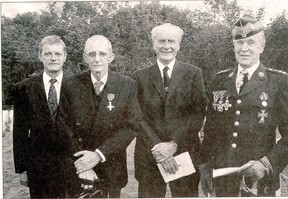 The Denmark Team (L-R: Inspector O. Ronnest, Anders Bjornvad MBE, NE Stampe, Col. HW Gram). |
It was inflated, afloat and was recovered by the Germans. One of the crew washed ashore had part of the dinghy's fender rope wrapped his fingers. Certainly they would have been in severe difficulties. Neils Stampe's report set out the incapacitating injuries they had suffered. All would have been affected by the April coldness of the sea, the rapid change in body temperature numbing them perhaps into their passing.
Eye-witnesses spoke of the pilot staying with the aircraft to attempt a controlled landing. Possibly that was when Kenneth Rees the pilot received a head injury. At about noon on 29th April the Germans went to the wreck in a rubber boat and to retrieve the pilot's body from the cockpit. Thirteen year old Elin Ostergaard ran to her house to get a blanket to cover the body and placed a bunch of flowers - elsewhere in Occupied Europe she could have been severely punished.
Alex Cochrane was the other crew member who definitely did not drown. Like those who baled out he landed in the sea. As luck would have it he latched onto a wooden stake, used by fishermen to hang their nets. It appeared that to keep from drowning, he managed to strap himself to the post with his parachute harness. But though the sea did not get him the cold did. In the late morning his body was spotted by a fisherman, who brought it ashore with help from the Germans. It was noted that he had lost his teeth. So his injuries were not quite so horrific as Jim had imagined - though bad enough.
Even when crews managed to abandon their stricken aircraft they still faced the perils of parachuting, landing and - depending on where they came down - a hostile reception from civilians as well as the uniformed foe. In early 1943, the Germans in Denmark still adopted a correct attitude to their fallen foes. Neils Stampe wrote to Jim "Standing at the side of a grave ends all enmity," they said "whatever his behaviour has been like, whatever views he has had, we now look at a dead adversary without indignation and behold him simply as a dead human being who fought bravely and died for his country, and therefore we show him the last military honours." Later that year, as the tide turned against Nazi Germany, the German attitude changed towards the Allied airmen, now terrorfliegeren.
In early 1998 Jim joined the 207 Squadron Royal Air Force Associationas a Friend Member in order to continue the family link to the Squadron.
17th September 1998, Lemvig Cemetery, DenmarkThe Cochranes flew to Denmark as guests of the Royal Air Force and on 17th September took part in the dedication of new headstones in Lemvig Cemetery. Also in the party were Margaret and Susan Gould, nieces of Sgt Stanley Cowham. The RAF padre was The Reverend Gp Capt Gerald Moore, accompanied by two RAF escorts: he was assisted by Sognepraest E Bitsch; Cdr AC Gordon Lennox RN, (British Defence Attache), Wg Cdr RW King RAF (HQ BALTAP), the British Consul, the Danish Research Team and the Lord Mayor of Lemvig were among other distinguished guests. The service at each graveside was short, dignified and colourful. Wreaths were laid at both graves and the Cross of Sacrifice. They shall not grow old as we who are left
grow old. That was tough for Jim. |
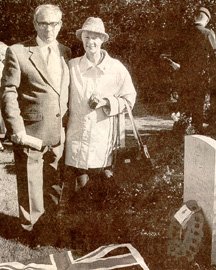 Jim and Margaret Cochrane at Lemvig Cemetery |
They went on to the village of Gudum to visit the local archives. Over tea and cakes Jim had an emotional meeting with Elin Ostegaard, who as a thirteen year old had rushed to her home to get a blanket and flowers to give dignity to the dead pilot.
The following morning they all returned to the Cemetery for one last look. Jim watched the RAF padre say a silent prayer over each of the graves. He finished and turned to Jim "They were all such brave young men," he said "I hope we did them justice."
And again
Shortly after his return home Jim was persuaded that the story should be told and so it was that Scotland on Sunday arranged for Jim to return to Lemvig with a photographer and reporter. Jim stood on the remains of the gun emplacement at Oddesund. The wind was blowing and the sea was certainly not the mill-pond of his last visit. Mads Jacobsen confirmed it had been just as rough the night the plane came down, but much, much colder.
Neils Stampe met them in the cemetery. They talked about the recovery of the bodies - "When the bodies of all the crew were either brought ashore or found on the beach, all their personal belongings and valuables were parcelled up to be sent home via the Red Cross. When it came to Alex and Stanley, neither of them had anything to be sent home, not even their dog tags. Their bodies had been looted ..." said Neils.
Someone had suggested to Jim that Alex had forgotten to put his ID discs on that night, but which serviceman ever took them off? Jim said quietly "Don't be angry Neils - the matter is of no consequence anymore. What counts now is that a wrong has been made right and that two brave young men can now rest in peace." Silent, he said his last goodbyes and stepped forward to touch Alex's headstone. The wind was blowing, the air had a bite, but to Jim the slab felt warm.
And so from the official honours paid by an enemy to unknown enemy airmen, to the RAF half a century later paying tribute to those same airmen is perhaps but a small piece of history. At least now those boys are - for the families and those involved - at rest. As Jim was quoted in a Danish newspaper "It is wonderful that they have done this. It gives us as relatives peace of mind and we can put a name on the tombstone and know that he has not just been buried as unknown."
And the 'Denmark Team'? "It was the least we could do. They gave their lives." That's the explanation they gave when asked why they had put so much effort into identifying the two men from 207 Squadron and two others from other units who were also identified at long last (Thomas Carter and Roland Stanley Sidwell).
A fifth man, Reginald Alfred Whellams, who was found in Ringkobing Fjord in 1996 was also laid to rest. Lemvig was, they thought, their last case. They had identified many servicemen all over the country, and though they had no more cases on file, they knew more could turn up. Now they were going to concentrate their work for the CWGC on making sure that all WWII monuments were in good repair. We are immensely grateful for what they have done.
| Sgt Stanley Cowham, the Mid-Upper Gunner, was the great uncle of Katherine Eastwood. In 2009 she wrote: He was the younger brother of my gran, Joyce Briggs, and although we have known his whereabouts since 1998 - my fathers cousins, Margaret and Susan flew over for the dedication of new headstones in Lemvig Cemetery, I see there is very little known/mentioned about him. Here is his photo. | 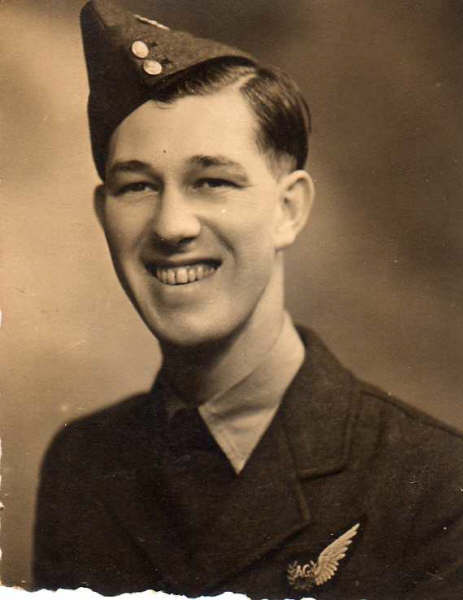 |
The tragic record
What do we now know of that tragic night? The Bomber Command War
Diaries account begins with an uncanny coincidence for 207
Squadron readers and provides an explanation for why it was such an
appalling night for the RAF:-
'28/29 April 1943
MINELAYING
207 aircraft - 68 Lancasters, 60 Halifaxes, 47 Wellingtons, 32
Stirlings - carried out another large minelaying operation. 167 aircraft
laid 593 mines off Heligoland, in the River Elbe and in the Great and
Little Belts. Low cloud over the German and Danish coasts forced the
minelayers to fly low in order to establish their positions before
laying their mines and much German light Flak activity was seen. 22
aircraft - 7 Lancasters, 7 Stirlings, 6 Wellingtons, 2 Halifaxes - were
lost. This was the heaviest loss of aircraft while minelaying in the
war, but the number of mines laid was the highest in one night. [Website
Editor: for the families of those crews, it was the loss of their men,
not aircraft, that has to be weighed in the equation, despite the
exigencies of war.]
6 Mosquitoes carried out a raid to Wilhelmshaven, dropping many flares
to divert attention from that part of the minelaying force which was
operating nearby. No Mosquitoes lost.'
Bill Chorley's 1943 volume in his Bomber Command Losses of the Second World War series gives us the list of those who did not return, given here by Squadron, target code names, aircraft, pilot and casualties (POW=Prisoner of War, kia=killed in action). He lists 23 aircraft rather than the 22 in Bomber Command War Diaries. By any standards it is a sombre list - only 4 survivors from the crews of 23 aircraft:-
| 12 Sqn, Wickenby (Lancasters) | Spinach | W4954 PH-V | Flt Lt RH Ashton | 7 kia |
| Spinach | ED325 PH-J | P/O LWG Head DFM | 7 kia | |
| Spinach | ED408 PH-A | Sgt G Elsworthy | 7 kia | |
| Geraniums | LM313 PH-D | Sqn Ldr EF Tyler | 7 kia | |
| 61 Sqn, Syerston (Lancasters) | Baltic | W4898 QR- | W/O MdeB Collenette DFM | 7 kia |
| 75 Sqn, Newmarket (Stirlings) | Radish | R9290 AA-X | F/S AE Lewis RAAF | 7 kia |
| Radish | W7513 AA-G | Sgt K Halliburton RNZAF | 7 kia | |
| Radish | BF467 AA-W | P/O DL Thompson RNZAF | 7 kia | |
| Radish | BK807 AA-M | P/O DV Hamer | 7 kia | |
| 90 Sqn, Ridgewell (Stirlings) | Quince | BF346 WP-G | Sqn Ldr RS May | 7 kia |
| 103 Sqn, Elsham Wolds (Lancasters) | Tangerines | ED733 PM-X | Sgt AD Nicholson | 7 kia |
| 158 Sqn, Lissett (Halifaxes) | Silverthorne | HR773 NP-A | P/O RD Roberts DFM | 7 kia |
| 166 Sqn, Kirmington (Wellingtons) | not stated | HZ278 AS-N | P/O LM Clark RCAF | 4 kia, 1 POW |
| 196 Sqn, Leconfield (Wellingtons) | Forgetmenots | HE170 ZO- | Sgt FC Swain | 5 kia |
| Forgetmenots | HE220 ZO- | Sgt JF Atkins | 5 kia | |
| Forgetmenots | HE395 ZO- | Flt Lt IN Bonard | 5 kia | |
| 207 Sqn, Langar (Lancasters) | (Daffodils) | W4945 EM-Z | W/O KR Rees | 7 kia |
| 218 Sqn, Downham Market (Stirlings) | Sweet Pea | BF447 HA-F | P/O DJ Brown | 5 kia, 2 POW |
| Sweet Pea | EF356 HA-O | Sgt KS Hailey | 6 kia, 1 POW | |
| Sweet Pea | BF515 HA-N | Flt Lt GF Berridge | 7 kia | |
| 419 Sqn, Middleton St George (Halifaxes) | Silverthorne | JB923 VR-Q | Sgt GKA Smallwood RCAF | 7 kia |
| 428 Sqn, Dalton (Wellingtons) | Rosemary | HE543 NA-D | Sgt RA Parkinson | 5 kia |
| Rosemary | HE728 NA-B | Sgt KE Radcliff RCAF | 5 kia |
More information on the fate of this crew can be seen on the Airwar over Denmark website
This article is based on the account provided by Jim Cochrane; articles from Scotland on Sunday; articles translated from Danish newspapers, provided by Brian Howett and translated by his sister-in-law in Denmark; Bomber Command War Diaries, (Middlebrook and Everitt: Penguin); Bomber Command Losses of the Second World War, 1943 (WR Chorley: Midland Counties Publishing).
Picture credits: montage, Scotland on Sunday: Cochranes at the grave, Brian Dixon: Denmark Team, local Danish newspaper: grave 697, Jim Cochrane: Runnymede, CWGC: Denmark maps, Lemvig Tourist Office website; Gardening areas map, adapted from that in Francis K Mason's The Avro Lancaster (Aston).
Parts of this article were reproduced in the 207 Squadron
Newsletters during 1999.
updated on 17th July 2004, version 8 (Tyler link added)
updated 17th July 2005, Lemvig Tourist link updated
updated 24 Oct 2007 Airwar over Denmark link added
updated 18 Nov 17 links updated
Copyright James Cochrane and Frank Haslam: page last updated 7 Jan 19
Google Maps - Lemvig
